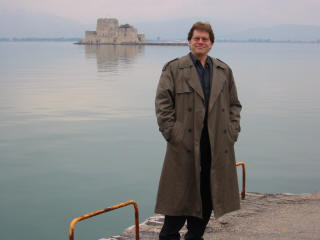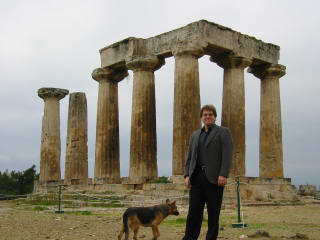|

    
Argolis region of the
Peloponnesian peninsula, west of Athens...
|
|

15th century Bourtzi Fortress in Nafplion Harbor |
The eastern part of the peninsula of Peloponnese has
some of the great treasures of Greece. I took a full day
tour with
George the famous taxi driver and covered almost
four millenniums of history making the circle of
Corinth, Mycenae, Nafplion and Epidaurus. The weather
was cool, but pleasant, with rain threatening most of
the day but never arriving. A couple of the stops
involved some real climbs, most notably Acrocorinth,
which is a fortress built in four levels on a 1885 ft.
high sheer cliff over Corinth with the pathways all
covered in slippery marble. |
|
|
Ancient Corinth
Leaving Athens heading west, we crossed over the Corinth
Canal, which was blasted out from solid rock in the late 19th
century (first picture below). The Ancient Corinth site starts
with a small, but competent museum that contains three rooms
of the site's artifacts (second picture below). The Temple of
Apollo (large picture at right with my new local guide) and
Roman Agora (yes there are places with the same names in
Delphi and
Athens) make up
a small city with a wide marble street and the remains of
homes, shops (third and fourth pictures below) and a well
preserved temple. |

6th century BC Temple of Apollo in Ancient Corinth |
|
Acrocorinth
Acrocorinth is a massive fortress perched on a cliff above
Ancient Corinth (first picture below at the top of the
mountain on the left). You drive about two thirds of the way
up and then you need to pull out your hiking shoes. The gate
(second picture below) is the beginning of a long steep climb
on slippery marble covered paths that goes up four levels
approaching the summit. From the first level you can see only
the next two (third picture below). I stopped climbing at the
third level which is at the top right of the third picture
below. It looked like another hour or more to the summit and
the view was already great. Driving back down the mountain, we
were stopped by a group of wild sheep crossing the road in a
flock (fourth picture below). I'll bet they made it all the
way to the top. |
|
Mycenae
Driving past countless orange groves we came to the ancient
Citadel of Mycenae. This was the oldest of the ancient sites I
visited, dating back to 1500 BC. The highlights were the
Lion's Gate (first picture below) and the famous, but
unimaginatively named, Grave Circle A, where in 1874 Heinrich
Schliemann excavated what he thought was the death mask of
Agamemnon (second picture below). Climbing up the steep hill,
I passed the ruins of houses and a small city (third picture
below) heading for the palace at the top. The views looking
over the valley were great, and I could see why this location
was easy to defend. The Mycenaeans fell victim to some unknown
disaster around 1100 BC and virtually disappeared by the time
the rest of ancient Greece was rising. The fourth picture
below shows the marble steps and walkways leading up to the
palace. |
|
Epidaurus
Heading down the hill from the Citadel, we stopped to visit
the Treasury of Atreus (entrance shown in first picture
below), which is a dark honeycomb shaped burial area called a
tholos tomb. After a quick stop to pick up souvenirs in
Nafplion (large picture top of page left) we drove north about
20 miles to visit the Theatre of Epidaurus (second picture
below), which is an acoustic wonder. They have a competent
museum attached, like many of the ancient sites, with a sample
of excavated treasures from the nearby Sanctuary of Asklepios
(third picture below). A short walk up the hill takes you to
the remarkably well preserved 4th century theatre which is
still used, seating 14,000. When you stand anywhere on the
stage you can whisper and be heard all the way up in the cheap
seats (fourth picture below). |

    
Mackey Group, Inc.
© 2002 - 2010
|
|